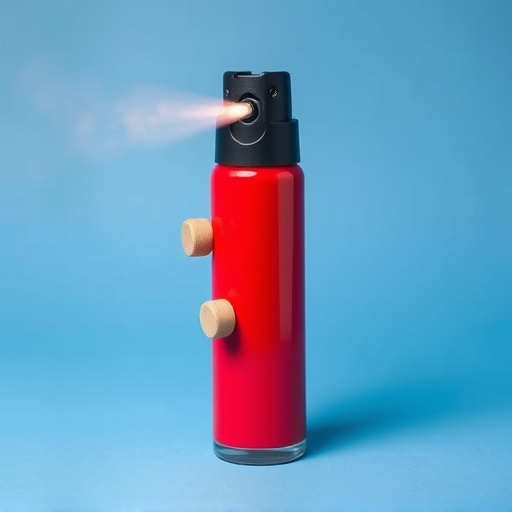Oleoresin capsicum (pepper spray) irritates skin through capsaicin and capsinoids, causing temporary pain. Prompt action is key for removal: rinse with cool water for 10-15 minutes, avoiding soap or hot water. Soothe affected areas with mild cleaners, emollients, calamine lotion, or anti-itch cream. For severe cases or eye/respiratory exposure, seek medical attention immediately. Always understand local laws and practice safe handling and disposal when using pepper spray for self-defense.
“Uncover the power of oleoresin capsicum spray as a personal defense tool. This comprehensive guide explores the science behind this spicy substance, its effects on potential attackers, and essential safety measures. Learn effective techniques for pepper spray removal from skin, offering immediate relief and aftercare tips to minimize discomfort. We also delve into legal considerations, ensuring responsible use. Understand the risks, benefits, and correct handling procedures of such devices, empowering yourself with knowledge in a potentially life-saving scenario.”
- Understanding Oleoresin Capsicum Spray: Composition and Effects
- Removing Pepper Spray From Skin: Immediate Steps and Techniques
- Aftercare and Treatment for Pepper Spray Exposure
- Legal Considerations and Safety Precautions for Using Pepper Spray Devices
Understanding Oleoresin Capsicum Spray: Composition and Effects
Oleoresin capsicum spray, commonly known as pepper spray, is a powerful defensive tool made from the capsaicin found in chili peppers. Its composition includes a complex mixture of capsinoids, which are responsible for the burning sensation it induces. When sprayed onto the skin or eyes, capsaicin disrupts normal cellular function, leading to temporary pain and disability. This disruption is what makes oleoresin capsicum spray an effective deterrent against potential threats.
Understanding how pepper spray interacts with the body is crucial in knowing how to remove its residual effects. Pepper spray removal from the skin typically involves thorough washing with soap and water, as the irritant can be easily washed away before it penetrates deeper layers of the skin. In case of contact with the eyes, immediate irrigation with clean water for at least 15 minutes is recommended. Medical attention might be necessary if severe irritation or discomfort persists, ensuring that the individual receives appropriate care after exposure to pepper spray.
Removing Pepper Spray From Skin: Immediate Steps and Techniques
In the event that pepper spray comes into contact with your skin, it’s crucial to take immediate action to remove it as swiftly and effectively as possible. The first step is to wash the affected area thoroughly with cool water for at least 10-15 minutes. This helps to dilute and disperse the capsaicin oil, which is what causes the burning sensation. Avoid using hot water, as it can exacerbate the irritation. After rinsing, gently pat the skin dry with a clean towel without rubbing, which could further spread the irritant.
For stubborn residue, you can try applying a mild soap or gentle cleanser to help remove any remaining pepper spray oil. Using an emollient cream or lotion afterward can also provide soothing relief and aid in maintaining moisture, especially if your skin feels dry or irritated. Remember, acting promptly is key to minimizing discomfort and potential long-term effects of pepper spray exposure.
Aftercare and Treatment for Pepper Spray Exposure
After coming into contact with oleoresin capsicum (OC) spray, proper aftercare is essential to ensure comfort and prevent potential complications. If OC spray gets onto your skin, quickly rinse the affected area with cool water for at least 15 minutes. This helps to dilute and remove the pepper spray residue. Avoid using soap or alcohol-based products as they can irritate the skin further. Calamine lotion or an anti-itch cream may provide some relief from the stinging sensation.
For more severe cases or if the spray gets into your eyes, seek medical attention immediately. Eye exposure requires prompt treatment to prevent long-term damage. If pepper spray has been inhaled, move to a well-ventilated area and try to rest. Inhalation symptoms can include coughing, difficulty breathing, and chest tightness, so it’s crucial to ensure the individual receives fresh air. For any skin irritation or discomfort, over-the-counter hydrocortisone cream or oral antihistamines can help alleviate symptoms. Remember, prompt action is key in managing pepper spray exposure, especially when dealing with sensitive areas like the eyes and respiratory system.
Legal Considerations and Safety Precautions for Using Pepper Spray Devices
Using pepper spray as a self-defense tool is a powerful option, but it’s essential to be aware of the legal implications and safety precautions associated with its use. Each jurisdiction has specific laws governing the possession and use of pepper spray devices, so understanding your local regulations is crucial before considering this method for personal protection. Some areas may permit its use only by law enforcement or require permits for private individuals.
When it comes to safety, proper handling and application are key. Users should receive training on how to deploy the spray effectively while minimizing the risk of cross-contamination, as pepper spray removal from skin can be challenging. It’s recommended to practice safe disposal methods to prevent any potential harm to others or oneself. Always keep in mind that pepper spray is a powerful irritant and should only be used when necessary, ensuring that alternative self-defense options are considered first.
Oleoresin capsicum (OC) spray, a powerful defense tool, can cause significant irritation but also offers important protection. Understanding its composition and effects is crucial for effective usage and subsequent aftercare. Prompt action to remove pepper spray from the skin via immediate washing with water and mild soap is essential, along with knowing legal considerations and safety precautions. By following these steps, users can minimize discomfort and ensure responsible OC spray application.
